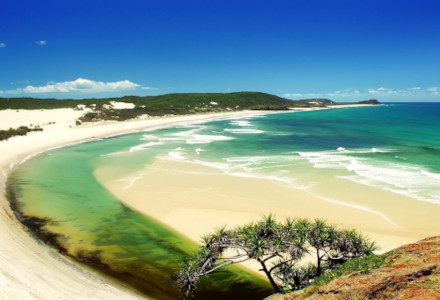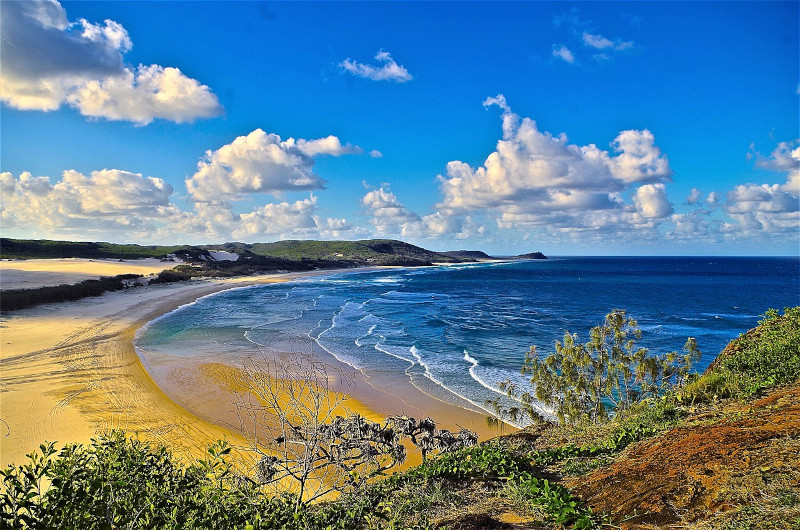Fraser Island Facts
- This breathtaking geological formation, holding numerous natural wonders, remains most widely known by its english name of Fraser Island. Yet it’s also known by other terms. Those stem from the languages of two originally present Indigenous Peoples.
- The term K’gari, therefore, comes from the language of the Butchalla aborignes. In the mother tongue of the Badtjala people, however, it’s known by the term of Gari. Regardless of the name one applies, though, it’s an astounding natural marvel.
- Archaeological evidence indicates that local populations appeared on the island at least 5,000 years ago. In more recent times, though, outsiders did not discover it until the British explorer James Cook sighted it in 1770. But he did not land on it at that time.
- The first known non-native presence on the island occurred in 1802. That’s because, at that time, the lesser-known British explorer, Matthew Flinders, landed at roughly the most northerly point of the site. Thereafter, it briefly bore the name Great Sandy Island.
- Thankfully, the incredible beauty of Fraser Island garnered it great appreciation by many, including UNESCO. Due to that, the organization named it a World Heritage Site, in 1992. This further led to its renaming to the aboriginal name of K’gari, in 2021.
- Though it’s a popular tourist destination, the island does have a measure of protection. This holds true due to the fact that it now forms part of the Great Sandy National Park. Measures thus remain in place to monitor and protect it from human depredations.
Related Articles
Fraser Island Physical Description
The magnificent Fraser Island fully merits appreciation for its wonders. It further does so for not merely one, but several reasons. Though certainly not its greatest attraction, the sheer size of the site nonetheless deserves respect and mention in any article dealing with it.
That’s because it boasts an impressive total area. More precisely, this equals roughly 710 sq mi (1,840 sq km). Its overall shape, however, garners some notice from those who visit the site. In fact, the location has a roughly, though highly elongated, general shape to it.
Though its outline understandably remains highly irregular in general shape, some approximations can nevertheless be made. Regarding these, the island measures roughly 76 mi (123 km) in length. Overall, though, its width only measures about 14 mi (22 km).
Yet it also stands out for another reason. That’s true since it ranks as the largest of all islands of its type, known as sand islands. As the term implies, such islands have a composition composed primarily of sand. This nature alone distinguishes it from many others.
Its wonders only become even more impressive from there, however. Nature truly outdid itself in its creation. Despite its large sand component, the amazing Fraser Island also boasts numerous geological features that might surprise some individuals with their presence.
These include numerous free-flowing freshwater creeks, for one. Multiple sand dunes further add to its visual appeal. Astonishingly, it also holds more than 100 lakes! These additionally hold some of the cleanest naturally occurring freshwater known to man.
Fraser Island Location, Formation, and Ecology
The awe-inspiring structure still best known as Fraser Island even holds one more intriguing statistic. It formed in a part of the world already well known for its abundance of natural marvels. That’s because it lies just off the coast of the gorgeous continent of Australia.
More precisely, it formed off the eastern coast of the landmass. However, the extremely elongated island varies in proximity to the continent. Part of it lies relatively close to the shore, and roughly parallels it. Another section, though, angles sharply away from it.
This marvel of geology began its formation around 750,000 years ago. At that time, sand began to accumulate on volcanic bedrock. Over time, a strong offshore current carried prodigious quantities of this northward, along the coastline of the continent.
Despite its largely sand-based composition, the island boasts a rich and diverse ecosystem. That’s due to the presence of a naturally occuring mycorrhizal fungi present in the sand. This naturally releases nutrients into the sand otherwise absent, allowing life to flourish.
Due to the unique circumstances present on Fraser Island, an astonishing 865 known species of flora appear there. Adding to its distinction is the fact that it’s the only place on the planet where a large rainforest grows in sand. What wonders lie within its boundaries!
Mammalian species also appear, numbering an estimated 25 – 50. These include Swamp Wallabies and Bandicoots, among others. A known total of 74 species of reptiles additionally live here, including 18 types of snakes. An amazing 350 species of birds also live here.
Features Sharing Its Region
Check out our other articles on 5 Befuddling Invertebrates of Borneo, Yellow Throated Marten, Grand Prismatic Spring, African Tulip Tree, Hibiscus Harlequin Bug, Saltwater Crocodile


